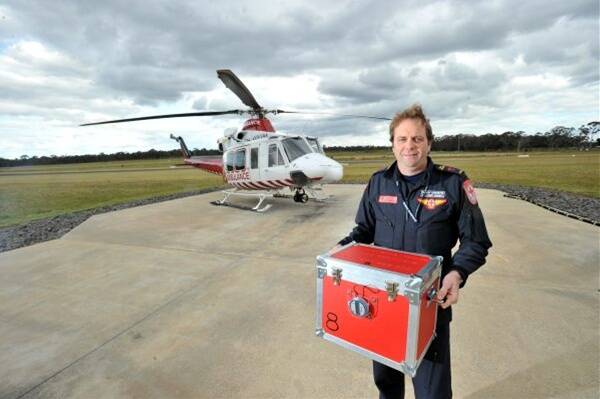
A SERIOUSLY injured road accident victim has become the first person to receive an emergency mid-air blood transfusion delivered by a paramedic on Bendigo’s air ambulance.Advanced life support and intensive care paramedics were flown to a crash at the intersection of Old Tarnagulla and Poseidon roads at Tarnagulla on Tuesday afternoon.An 18-year-old woman was one of three people injured when a car hit a tree.Melbourne-based intensive care flight paramedic Michael Wells first treated the woman, who was lying on the ground beside the back door of the car.“She looked very pale, almost see-through, with a wound to her abdomen that was continuously bleeding,” he said.He said the woman also suffered a fractured pelvis and a head injury. “She was conscious but confused,” Mr Wells said.“She had very little recollection of the crash and couldn’t remember how she got out of the car.“Initially, we couldn’t even read her blood pressure. A drip was used to give her saline fluids and pain relief. “We also placed a splint around her shattered pelvis to support it and a neck brace was used in case she had suffered a spinal injury.’’Mr Wells delivered a historic blood transfusion to the injured woman as she was flown to The Alfred hospital trauma unit.“Once she was on board the helicopter, although her blood pressure had improved slightly, her condition was still unstable so I consulted with a doctor to give her a blood transfusion,” he said.Bendigo air ambulance base manager Murray Barkmeyer said it was the first time a paramedic on the city’s helicopter had performed a blood transfusion in mid-air.‘Essentially, it gives us another tool,” he said. “Before blood became available to us we were infusing patients with a saline fluid but now we are able to give a blood transfusion.“Blood is more beneficial than saline to the patient because of its ability to carry oxygen to the major organs.”Mr Barkmeyer said the method used by air ambulances to carry and store blood was vital to the program.“Because it is a world first for paramedics to carry blood on board a helicopter, we had to design special refrigeration units for it,” he said.“Our specialised ‘shipper’ is able to keep the blood at the specified temperature for a long period of time. Every minute or so the temperature is data-logged to confirm that the blood is being stored properly.“There are many factors that play a role in improving a patient’s chance of survival and ultimately a better quality of life.”The program first became available on air ambulance helicopters based at Essendon in April. The resources are being rolled out to the country and will be available at all bases by the end of the year.The Alfred could not provide details last night on the condition of the two women flown to the hospital from the crash site.
Subscribe now for unlimited access.
$0/
(min cost $0)
or signup to continue reading

